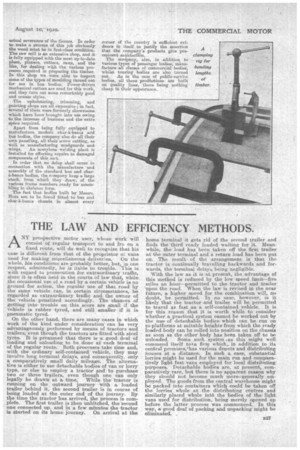THE LAW AND EFFICIENCY METHODS.
Page 25

If you've noticed an error in this article please click here to report it so we can fix it.
ANYprosPective motor user, whose work will consist of regular transport to and fro on a fixed route, will do well to recognize that his case is different from that of the proprietor of vans used for making miscellaneous deliveries. On the whole, his conditions are probably better, but, in one respect, admittedly, he is liable to trouble. This is with regard to prosecution for extraordinary traffic, since it is often held in the courts of law that, while the occasional use of a road by a certain vehicle is no ground for action, the regular use of that road by the same vehicle can, in certain circumstances, be regarded as extraordinary traffic and the owner of the vehicle penalized accordingly. The chances of getting into trouble on this score are small if the vehicle is rubber tyred, and still smaller if it is pneumatic tyred.
On the other hand, there are many cases in which work Of the kind under consideration can be very advantageously performed by means of tractors and trailers, even though the tractors are fitted with steel tyres. It is presumed that there is a good deal of loading and unloading to be done at each terminal of the regular route. Both processes take time and, with the ordinary self-contained vehicle, they may involve long terminal delays, and consequently, only a comparatively small daily mileage. The alternative is either to use detachable bodies of van or lorry type, or else to employ a tractor and to. purchase two or three trailers, even though one can only legally be drawn at a time. While the tractor is running on the outward journey with a loaded trailer behind it, the second trailer is in course of being loaded at the outer end of the journey. By the time the tractor has arrived, the process is complete. The first trailer is then unhitched, the 'second one connected up. and in a few minutes the tractor is started on its home journey. On arrival at the
borne terminal it gets rid of the second trailer and finds the third ready loaded wafting for. it. Meanwhile, the load has been taken off the first trailer at the outer terminal and a return load has been put on. The result of the arrangement is that the tractor is continually travelling backwards and forwards, the terminal delays being negligible.
With the law as it is at.present, the advantage of this method is reduced by the low speed limit—five miles an hour—permitted to the tractor and trailer upon the road. When the law is revised in the near future, a higher speed for the combination will, no doubt, be permitted. In no case, however, is it likely that the tractor and trailer will be permitted to travel as fast as a self-contained vehicle. It is for this reason that it is worth while to consider whether a practical system cannot be worked out by -the use, of detachable bodies, which can be run on to platforms at suitable heights from which the ready loaded body can be rolled into position on the Chassis as soon as the other body has been taken off to be unloaded. Some such. system I as this might well commend itself tol a firm which,, in addition to its central premises, 'has various depots and distributing houses at a distance. In such a case, substantial lorries might be used for the main rim and comparatively light fast vans employed for local distributing' purposes. Detachable bodies are, at present, comparatively rare, but there is no apparent reason why they should not become much more.; generally sinployed. The goods from the central warehouse might be packed into containers which could be taken off the lorries whole at the distributingcentres and similarly placed whole into the bodies of the light vans used for distribution, being merely opened up before the latter process was commenced. In this way, a good deal of packing and unpacking might be eliminated. .






























